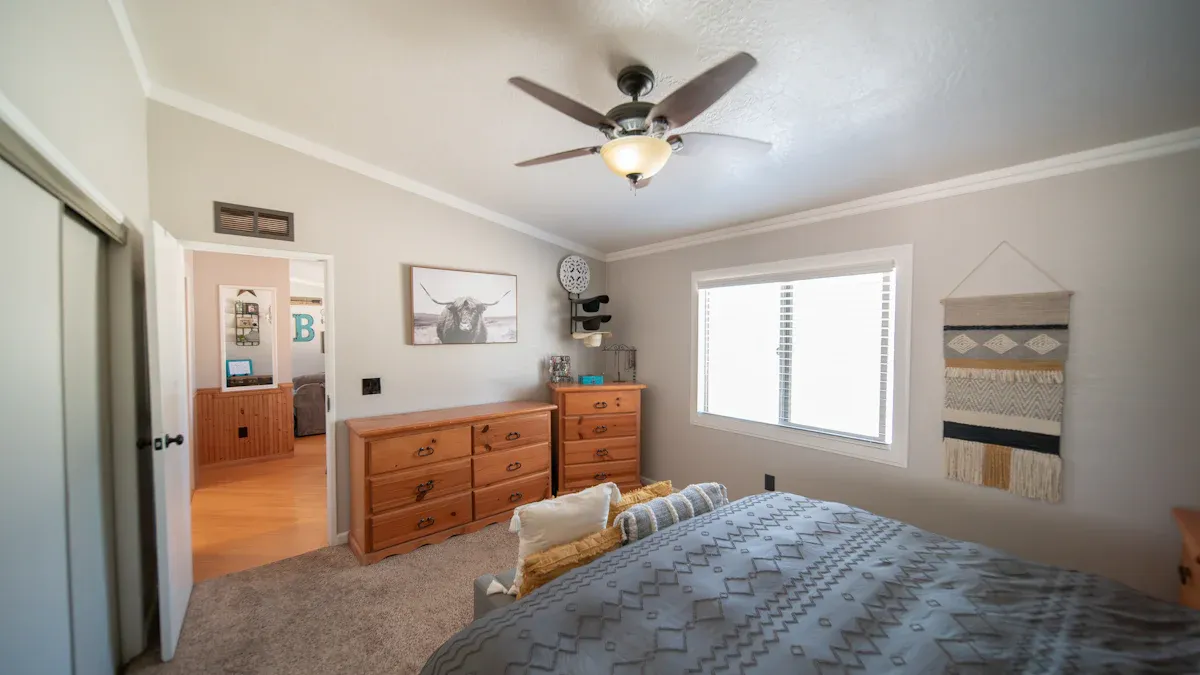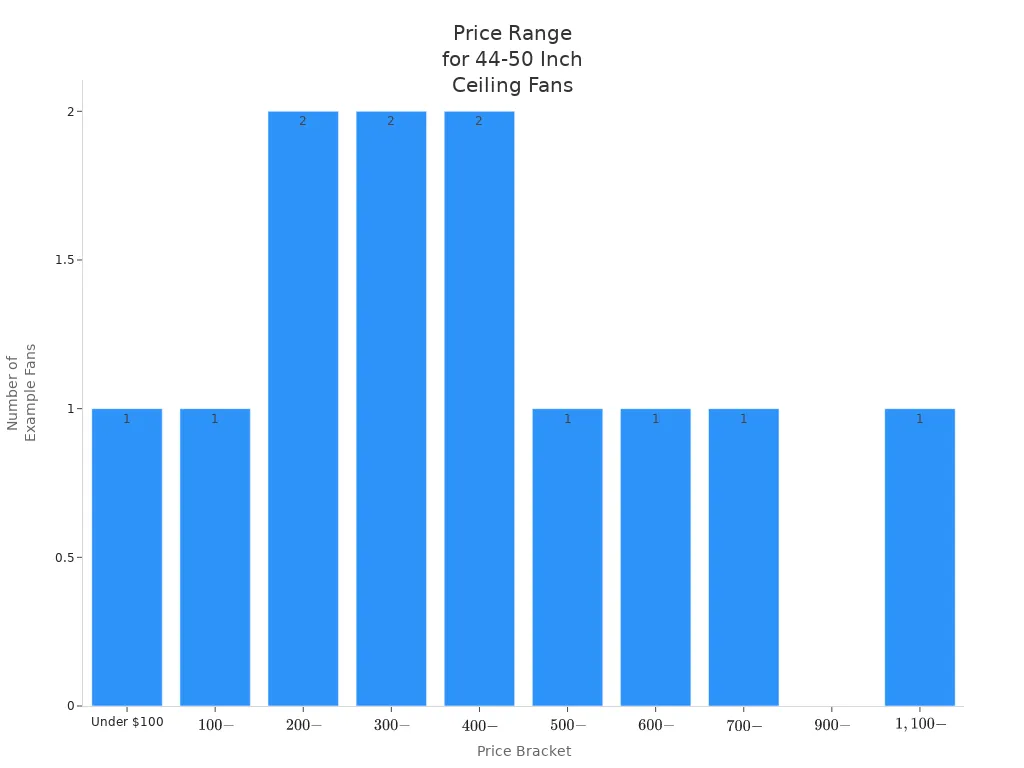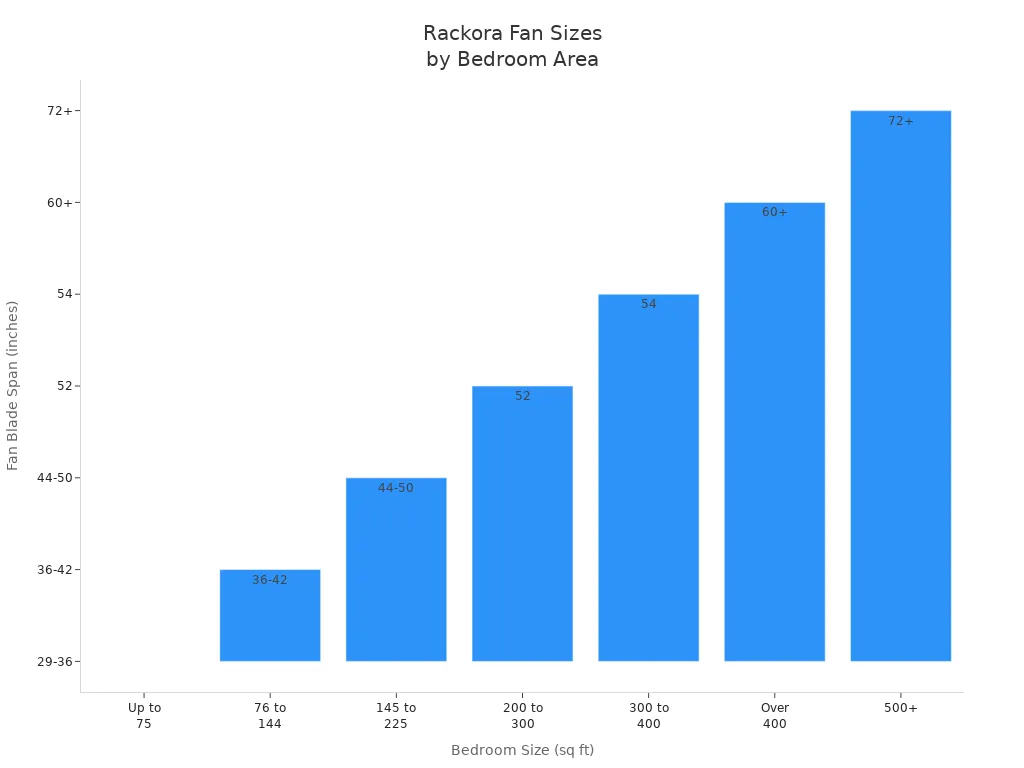You might wonder if a 44 inch fan is too small for your bedroom. The answer depends on why you want the right ceiling fan size for your space. A fan that matches your room size improves comfort and helps you sleep better. If the fan is too small, you may not feel cool or relaxed. Choosing the right fan ensures you enjoy steady airflow and lasting comfort in your bedroom.
Key Takeaways
- Measure your bedroom size before buying a ceiling fan to find the right blade span for your space.
- A 44 inch fan works best in medium bedrooms between 40 and 200 square feet for balanced airflow and comfort.
- Ceiling height affects fan mounting and performance; keep fan blades at least 7 feet above the floor for safety and efficiency.
- Using a fan too small for your room causes poor air circulation, hot spots, and forces the fan to overwork.
- Choosing the correct fan size saves energy, reduces noise, and extends the fan’s lifespan.
- Look for fans with quiet DC motors and aerodynamic blades for peaceful bedroom operation.
- Remote and smart controls add convenience and help you customize airflow and lighting easily.
- Rackora offers a wide range of ceiling fan sizes and features to fit different bedroom needs with style and efficiency.
Bedroom Size and Ceiling Fan Size

Measuring Bedroom Size
Choosing the correct size ceiling fan for your bedroom starts with measuring the room. You need to know the length and width of your space. Multiply these numbers to get the square footage. This step matters because the size of your room directly affects how much air a ceiling fan can move. If you pick a fan that is too small, you will not feel enough airflow. If you choose a fan that is too large, it may overpower the space and look out of place.
Manufacturers use room size to recommend the right ceiling fan size. For example, a small room up to 100 square feet needs a fan with a blade span of 36 inches or less. Medium rooms between 100 and 300 square feet work best with a 44 to 52 inch fan. Large rooms over 300 square feet need a fan with a blade span of 54 inches or more. This method ensures you get the perfect fan size for comfort and efficiency.
Tip: Always measure your room before shopping for a ceiling fan. This step helps you avoid buying the wrong size ceiling fan.
Ceiling Height Factors
Ceiling height plays a big role in how well your ceiling fan works. The distance from the floor to the fan blades affects both safety and airflow. For standard 8-foot ceilings, you should use a fan with a short downrod or a flush mount. This keeps the blades at least 7 feet above the floor, which is safe and effective.
If your ceiling is higher than 8 feet, you need a longer downrod. This brings the fan down to the right height for good air movement. Vaulted or angled ceilings require special mounts to keep the fan level. Low ceilings may need flush mounts, but these can reduce airflow. In that case, pick a fan with a stronger motor to make up for it.
- Ceiling height determines the mounting method and the size ceiling fan you need.
- Fans should hang about 8 feet above the floor for the best cooling.
- Always check for at least 7 feet of clearance from the floor to the blades.
Fan Size Chart
You can use a ceiling fan size chart to match your room size to the right fan. This chart shows the most common ceiling fan sizes for different spaces:
|
Fan Size (inches) |
Room Size (feet) |
Typical Room Type(s) |
|---|---|---|
|
Less than 29" |
Less than 5x10 |
Hallways, Closets, Laundry Rooms |
|
Around 39" |
Up to 8x10 |
Large Bathrooms, Breakfast Nooks |
|
Around 42" |
Up to 10x10 |
Bedrooms, Offices, Kitchens |
|
Around 52" |
Up to 10x20 |
Master Bedrooms, Dining Rooms |
|
Greater than 56" |
Up to 20x20 |
Living Rooms, Great Rooms |

Most bedrooms in new homes measure between 120 and 400 square feet. For these spaces, a 42 to 52 inch ceiling fan usually works best. This range covers the most common ceiling fan sizes for bedrooms. Rackora offers a wide selection of ceiling fan sizes, from compact models for small rooms to large fans for spacious areas. You can find the perfect fan size for any room in your home.
Note: Using the correct size ceiling fan improves airflow, comfort, and energy efficiency. It also helps your fan last longer and keeps your room looking balanced.
44 Inch Fan in a Bedroom
Ceiling Fan Size Basics
You want your ceiling fan to match your room for the best comfort and efficiency. The right ceiling fan size ensures you get steady airflow and a pleasant environment. Manufacturers recommend a 44 inch fan for rooms between 40 and 200 square feet. This range covers most standard bedrooms. If your room is smaller than 40 square feet, a 44 inch fan may feel too strong and create drafts. If your room is larger than 200 square feet, the fan may not move enough air, leaving you feeling warm and uncomfortable.
A 44 inch fan sits in the middle of common ceiling fan sizes. It works well for medium-sized rooms, such as bedrooms, home offices, or guest rooms. You should always check your room’s measurements before choosing a ceiling fan size. This step helps you avoid poor air circulation or overpowering airflow.
Tip: Always match the ceiling fan size to your room’s square footage for the best results.
Room Size Impact
Room size has a direct impact on how well your ceiling fan performs. If you use a 44 inch fan in a room between 75 and 144 square feet, you will likely enjoy balanced airflow and good comfort. This size ceiling fan fits most standard bedrooms. If your room is much smaller, the fan may create too much wind, making the space feel drafty. If your room is much larger, the fan may struggle to cool the entire area.
Here is a table that shows how different ceiling fan sizes fit various room sizes and their airflow impact:
|
Room Size Category |
Recommended Fan Blade Size (inches) |
Typical Room Examples |
Airflow/CFM Implication |
|---|---|---|---|
|
Small Rooms (up to 75 sq ft) |
29 to 36 |
Small bedrooms, bathrooms |
Smaller fans move less air, suitable for confined spaces without overpowering airflow. |
|
Medium Rooms (75 to 144 sq ft) |
36 to 44 |
Standard bedrooms, home offices |
44-inch fans fall here, providing efficient airflow balanced for typical bedroom sizes. |
|
Large Rooms (144 to 225 sq ft) |
44 to 54 |
Larger bedrooms, living rooms |
Larger fans move more air, better for bigger spaces requiring higher airflow. |
|
Extra Large Rooms (>225 sq ft) |
54 and above |
Great rooms, open-plan areas |
Extra-large fans provide maximum airflow for very large spaces and high ceilings. |
You can see that a 44 inch fan is ideal for medium rooms. If you use a fan that is too small for a large room, you will notice poor air movement and hot spots. If you use a large fan in a small room, you may feel overwhelmed by the airflow. Matching the ceiling fan size to your room size helps you get the best comfort and energy efficiency.
Airflow and Comfort
Airflow is the key to comfort in your bedroom. A 44 inch fan can move enough air to keep you cool in a medium-sized room. The actual airflow depends on the fan’s motor, blade design, and speed settings. Energy-efficient fans, like those from Rackora, use advanced motors and blade angles to maximize airflow while using less energy.
If you use a 44 inch fan in a room that is too large, you may not feel cool, even at the highest speed. If you use it in a small room, you may feel too much wind, which can be uncomfortable. Properly matching the ceiling fan size to your room size ensures you get the right amount of airflow for comfort.
- A 44 inch fan is best for rooms between 40 and 200 square feet.
- Using a fan that is too small for your room leads to poor air circulation and reduced cooling.
- Using a fan that is too large for your room can create drafts and discomfort.
- Larger fans can move more air at lower speeds, which often means quieter operation and better energy efficiency.
You should also consider the price range when choosing a ceiling fan. Most 44 inch fans fall between $100 and $500, making them a popular choice for bedrooms and medium-sized rooms. Here is a chart showing the price distribution for 44-50 inch ceiling fans:

Rackora offers a variety of ceiling fan sizes, including 44 inch models, to help you find the perfect fit for your space. Their fans combine modern design, quiet operation, and energy efficiency, making them a smart choice for any bedroom.
Note: Always check the CFM rating of your fan to make sure it meets your comfort needs. The right ceiling fan size will help you stay cool, save energy, and enjoy a peaceful environment.
Signs a Ceiling Fan Is Too Small

Poor Air Circulation
You may notice poor air circulation when your ceiling fan is too small for your bedroom. This happens because the fan blades cannot move enough air to cover the entire space. When the fan size does not match the room, you feel stuffy or uncomfortable, especially during warmer months. Small fans often spin quickly, but they still fail to push air across the whole room. This leads to stagnant air and makes it hard for you to cool down or sleep well.
Poor circulation also means dust, pet dander, and other indoor particles stay trapped in the air. You might see more dust settling on surfaces or feel the air quality drop. Scientific studies show that weak airflow from a small ceiling fan allows airborne particles to linger, which can affect your comfort and health. You need a fan with the right size to create steady circulation and keep your bedroom fresh.
Tip: If you feel like the air in your room never moves or you notice dust collecting quickly, your ceiling fan may be too small.
Hot Spots in Room
Hot spots are another clear sign that your ceiling fan is too small. When the fan cannot circulate air evenly, some parts of your room feel warmer than others. You might notice that one side of your bed feels cool, while the other side feels hot and stuffy. This uneven temperature happens because small fans do not have the power to move air throughout the entire space.
Warm air rises and collects near the ceiling, especially in bedrooms with poor circulation. Without a proper air circulation solution, you get temperature differences between the floor and the ceiling. A small ceiling fan cannot break up these layers, so you end up with hot spots and cold spots. You want your ceiling fan to distribute air evenly, making the whole room comfortable.
- Hot spots make it hard to relax or sleep.
- Uneven temperatures can cause you to adjust your thermostat more often, wasting energy.
- A larger fan or a better air circulation solution helps even out the temperature.
Fan Overworking
A small ceiling fan often works harder than it should. You may find yourself running the fan at its highest speed all the time, but still not feeling cool. This overworking happens because the fan size is not enough for your room. The motor spins faster, trying to move more air, but it cannot keep up with the demands of a larger space.
When a fan overworks, it can wear out faster and become noisy. You might hear rattling or humming sounds, which disrupt your sleep. Over time, the extra strain can shorten the fan’s lifespan. You need a ceiling fan that matches your room size to avoid these problems. Choosing the right size ensures efficient circulation and keeps your fan running smoothly.
Note: If your fan always runs at top speed and still leaves you feeling warm, it is likely too small for your bedroom.
A ceiling fan that is too small for your bedroom creates several problems. You get poor air circulation, hot spots, and a fan that overworks itself. These signs show why matching the fan size to your room is important. The right ceiling fan size gives you comfort, better air quality, and a longer-lasting solution for your home.
Effects of Using a Small Ceiling Fan
Reduced Cooling
When you use a small ceiling fan in a bedroom that is too large, you will notice a drop in cooling effectiveness. A 44 inch fan works best in rooms up to 144 square feet. If your bedroom is larger, the fan cannot move enough air to reach every corner. This leads to weak air circulation and leaves parts of your room feeling warm and stuffy. You may find that areas farther from the fan stay hot, especially during summer nights.
A small fan cannot create the steady airflow needed for comfort in a big space. Stagnant air pockets form, and you lose the cooling effect you expect. You might try running the fan at its highest speed, but this is not a real solution. The fan’s performance drops, and you still do not get the cooling you need. For larger bedrooms, you need a fan with a bigger blade span to ensure proper circulation and comfort.
Note: Proper air circulation is key to a comfortable bedroom. A small fan cannot provide this solution in a large space.
Energy Use
You might think a small fan saves energy, but this is not always true. When a fan is too small for your room, it must work harder to try to keep you cool. Running the fan at high speeds all the time increases energy use. This is not an efficient solution for your bedroom. The fan’s motor strains to keep up, which can lead to higher electricity bills.
Larger fans are designed to move more air at lower speeds. This means they provide better circulation and use energy more efficiently in bigger rooms. If you use a small fan in a large space, you waste energy without getting the cooling you want. Choosing the right fan size for your room is the best solution for saving energy and improving performance.
- Small fans use less power in small rooms.
- In large rooms, small fans work harder and use more energy.
- Proper fan size selection is the best solution for energy efficiency.
Noise and Wear
A small fan in a big bedroom often creates more noise. The fan must spin faster to move enough air, which increases turbulence and sound. You may hear humming or rattling, especially at night when you want quiet. This noise can disturb your sleep and reduce comfort.
Larger fans can move the same amount of air at lower speeds. This results in quieter operation and better performance. When a small fan runs at high speed all the time, it wears out faster. The motor and blades experience more stress, which shortens the fan’s lifespan. You end up needing a new solution sooner than expected.
Tip: For a peaceful bedroom, choose a fan that matches your room size. This ensures quiet operation and long-lasting performance.
Choosing the Right Ceiling Fan Size
Fan Size Recommendations
Choosing the right ceiling fan size is essential for comfort, energy savings, and optimal performance in your bedroom. You want a fan that fits your space and meets your needs. Industry experts recommend matching the fan blade span to your room’s square footage. For bedrooms up to 100 square feet, a 36-inch fan works best. If your bedroom measures between 100 and 150 square feet, a 42-inch fan is ideal. For larger bedrooms, from 150 to 350 square feet, a 52-inch fan provides the correct size and airflow.
You should also consider ceiling height. Make sure there is at least 10-12 inches between the ceiling and the fan blades. This clearance helps the fan move air efficiently. If your ceiling is higher than 8 feet, use a downrod to lower the fan to the right height. Always measure your room before choosing the right size. This step prevents common mistakes, such as picking a fan that is too small or too large. A fan that is too small cannot circulate air well, while a fan that is too large may create uncomfortable drafts.
Tip: Avoid placing the fan near obstructions like tall furniture or beams. This ensures the best airflow and performance.
Rackora 42 Inch Ceiling Fan
If you want a quiet, stylish, and efficient solution for a medium-sized bedroom, the Rackora 42 inch Black Wood Ceiling Fan stands out. This fan features a 35W DC silent copper core motor, which keeps noise levels around 35 decibels. You can enjoy restful sleep without disturbance. The fan offers six speed settings, so you can adjust airflow to your liking. The reversible motor lets you use the fan for cooling in summer and air circulation in winter.
You control the fan with a remote, making it easy to change speed, direction, and lighting. The dimmable LED light offers three color temperatures, so you can set the mood or brightness you prefer. The timer function helps save energy by turning the fan off automatically. This ceiling fan size is perfect for bedrooms between 100 and 150 square feet, providing the right ceiling fan size for comfort and efficiency.
|
Feature |
Rackora 42-inch Ceiling Fan (Black Wood) |
Description/Specification |
|---|---|---|
|
Size |
42 inches |
Suitable for medium bedrooms |
|
Motor Type |
35W DC silent copper core motor |
Quiet operation (~35 dB noise level) |
|
Energy Efficiency |
Up to 65% more efficient than AC motors |
Saves electricity costs |
|
Noise Level |
Approximately 35 decibels |
Very quiet, ideal for bedrooms and nurseries |
|
Speed Settings |
6 speeds |
Precise airflow control |
|
Motor Direction |
Reversible DC motor |
Summer cooling and winter air circulation |
|
Control |
Remote control |
Adjust speed, direction, timer, and lighting |
|
Lighting Options |
Dimmable LED with 3 color temperatures |
Adjustable brightness and mood lighting |
|
Timer Function |
Yes |
Energy saving by automatic shutoff |
Other Rackora Options
Rackora offers a wide range of ceiling fan sizes to match every bedroom. If your room is small (up to 75 square feet), you can choose a fan with a blade span between 29 and 36 inches. For medium bedrooms (76 to 144 square feet), the 36 to 42 inch models provide the perfect fan size and quiet operation. Larger bedrooms (145 to 225 square feet) benefit from 44 to 50 inch fans, while rooms up to 300 square feet work best with a 52 inch fan. For extra-large bedrooms, Rackora has 54 inch and even 60 inch models, ensuring strong airflow and top performance.

You can find a solution for any room size, including custom options for very large or unique spaces. Choosing the right size from Rackora’s collection means you get the correct size, quiet operation, and energy savings. This approach helps you avoid common mistakes and ensures your ceiling fan delivers the best performance for your bedroom.
Ceiling Fan Features for Bedrooms
Quiet Operation
You want your bedroom to be a peaceful place. A quiet ceiling fan helps you relax and sleep better. Noise from a fan can disturb your rest, so you should look for models that promise whisper-quiet operation. Fans with noise ratings under 40 decibels are best for bedrooms. DC motors are a top choice because they run smoothly and quietly, often below 35 decibels. These motors also use less energy and do not create the humming sounds that older AC motors make.
A well-designed fan blade also matters. Balanced blades reduce vibration and noise. Aerodynamic shapes help move air efficiently without extra sound. The right blade size for your room improves air circulation and keeps noise low. High-quality motors and proper fan sizing work together to give you a silent, comfortable environment.
- DC motors provide silent, energy-saving performance.
- Balanced, aerodynamic blades reduce noise and improve airflow.
- Proper fan size for your room prevents extra noise and wear.
Tip: Choose a ceiling fan with a DC motor and aerodynamic blades for the quietest bedroom experience.
Lighting Options
Lighting is another important feature in bedroom ceiling fans. You need good light for reading, dressing, or relaxing. Most modern ceiling fans use LED lighting. LEDs are energy-efficient and last much longer than old bulbs. They also stay cool, which helps keep your room comfortable.
Many ceiling fans offer integrated LED lights. These lights fit neatly into the fan’s design and give your bedroom a clean, modern look. Some fans let you adjust the brightness or color temperature, so you can set the mood for any time of day. Flush mount fans with LED lights are great for rooms with low ceilings, giving you both light and airflow without taking up extra space.
- LED lights save energy and last longer.
- Integrated lighting creates a sleek, modern style.
- Adjustable brightness and color temperature add comfort and flexibility.
Note: LED lighting is now the standard for bedroom ceiling fans because it combines efficiency, style, and comfort.
Remote and Smart Controls
You want convenience in your bedroom. Remote and smart controls make using your ceiling fan much easier. With a remote, you can change the fan speed or turn the light on and off without getting out of bed. Smart controls take this further. You can use your phone or voice commands to control the fan from anywhere in your home.
Smart ceiling fans connect to home systems like Alexa or Google Home. You can set schedules, automate fan speeds, or adjust lighting based on your needs. Some smart fans use sensors to detect room temperature or if someone is in the room. This helps save energy and keeps your bedroom comfortable all night.
These features give you more control and make your bedroom more comfortable. You can create the perfect environment for sleep, reading, or relaxing with just a few taps or voice commands.
Block Quote: Smart controls and remotes let you adjust your ceiling fan and lighting anytime, making your bedroom more comfortable and energy-efficient.
Selecting the right ceiling fan size for your bedroom matters for both comfort and energy savings. Studies show that matching fan blade span to room size improves airflow and efficiency. See the table below for guidance:
|
Room Size (sq ft) |
Recommended Fan Blade Span (inches) |
|---|---|
|
Up to 75 |
29 to 36 |
|
76 to 144 |
36 to 42 |
|
145 to 225 |
44 to 50 |
A 44 inch fan works best in medium bedrooms. For the best blend of style, quiet operation, and performance, you should consider Rackora’s ceiling fan collection.
FAQ
Why does ceiling fan size matter for bedrooms?
Ceiling fan size matters because it affects how well air moves in your room. If you choose the right size, you get better airflow and comfort. A fan that is too small cannot cool your room properly.
Why should you avoid using a fan that is too small?
A small fan cannot move enough air. You may feel hot spots and poor circulation. The fan will work harder, make more noise, and wear out faster. You will not get the comfort you want.
Why do experts recommend measuring your room before buying a fan?
Measuring your room helps you pick the right fan size. You avoid buying a fan that is too small or too large. This step ensures you get the best airflow and energy savings.
Why do ceiling height and mounting type affect fan performance?
Ceiling height and mounting type set the fan at the right level. If you install the fan too high or too low, airflow drops. The right setup keeps your room safe and comfortable.
Why do energy-efficient fans work better in bedrooms?
Energy-efficient fans use less power and run quietly. You save money on electricity. These fans also help you sleep better because they do not make much noise.
Why do you need quiet operation in a bedroom fan?
Quiet fans help you relax and sleep. Loud fans can disturb your rest. A fan with a DC motor and balanced blades keeps noise low and comfort high.
Why do modern ceiling fans include remote or smart controls?
Remote and smart controls make it easy to adjust your fan. You can change speed or lighting without getting up. This feature adds convenience and helps you create the perfect bedroom environment.
Why should you consider Rackora for your ceiling fan needs?
Rackora offers fans with modern design, quiet motors, and energy-saving features. You get style and performance in one product. Their fans fit many room sizes, so you find the right match for your bedroom.
